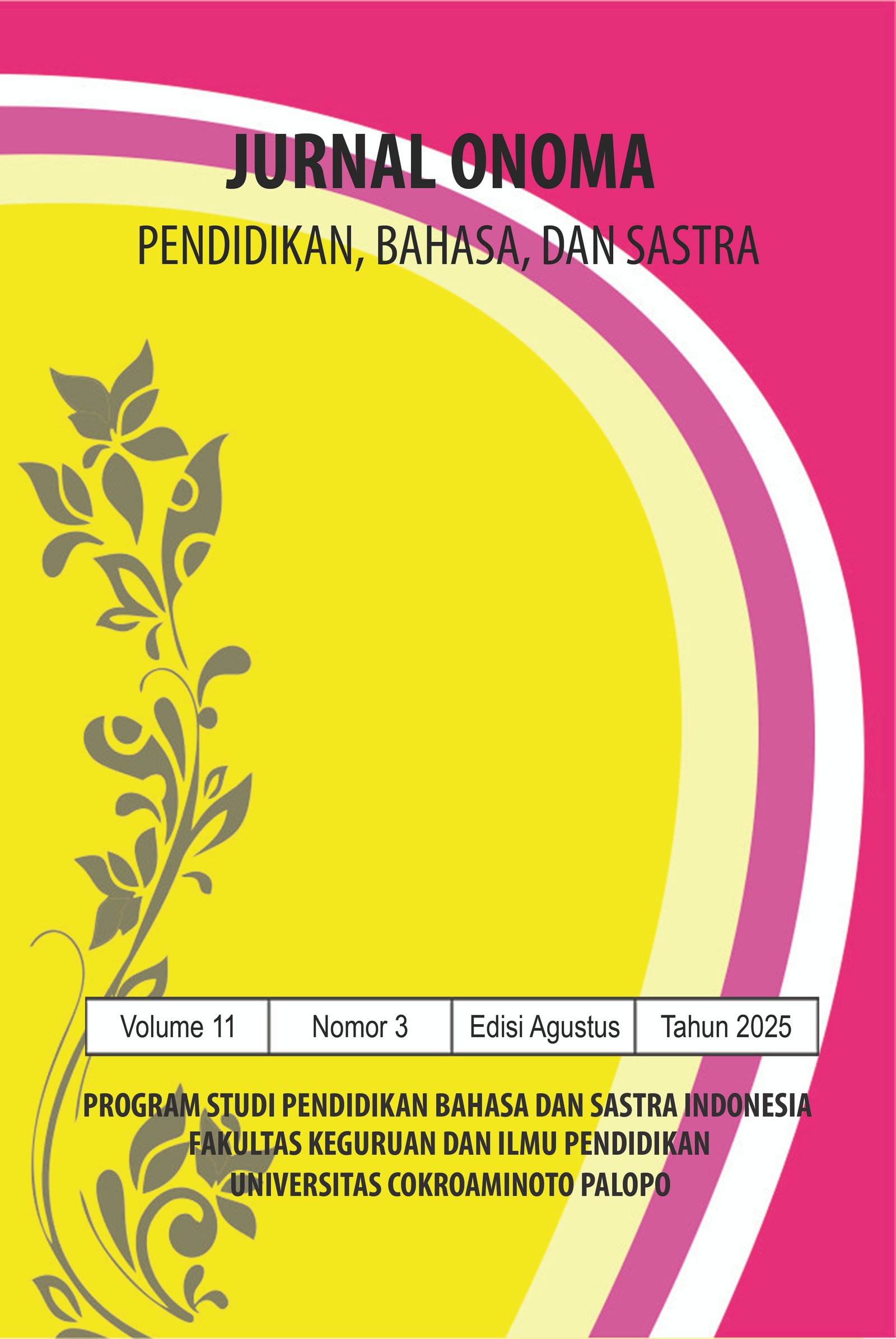Transformasi Maskulinitas dari Film Catatan Si Boy (1987) Menuju Film Catatan Si Boy (2023)
https://doi.org/10.30605/onoma.v11i3.6413
Keywords:
Catatan Si Boy; film remake; maskulinitas; R.W. ConnellAbstract
Film remake Catatan Si Boy banyak menuai komentar negatif dalam konten trailer di media sosial karena tokoh Boy dianggap terlalu feminin dan jauh dari tokoh Boy di film orisinilnya yang maskulin. Penelitian ini memperlihatkan perbandingan antara maskulinitas pada film orisinil dan transformasinya pada film remake tanpa mengurangi esensi dan pesan utama dalam film. Penelitian ini merupakan penelitian kualitatif deskriptif dengan metode analisis isi menggunakan teori maskulinitas Connell (2005). Sumber data utama atau data primer adalah dari film Catatan Si Boy (1987) dan film Catatan Si Boy (2023). Adapun data sekunder didapatkan dari buku dan jurnal pendukung. Hasil penelitian menunjukkan bahwa model struktur gender yang diaplikasikan pada film Catatan Si Boy (1987) adalah cathexis dan hegemoni maskulinitas. Film versi orisinil tersebut menganut maskulinitas tradisional, sedangkan maskulinitas yang dikonstruksikan dalam Catatan Si Boy (2023) adalah maskulinitas modern. Pergeseran ini mendekonstruksi ideologi maskulinitas yang ada di Indonesia.
Downloads
References
Azzahra, F. A., Hidayatullah, K., Wildan, M., Firmansyah, K., Answend, M., Yustika Saerang, V., Arifin, D., & Sholihatin, E. (2024). Analisis Love Language yang Digunakan Generasi Z dalam Membangun Hubungan Personal. Jurnal Ilmiah Wahana Pendidikan, 10(12), 214–229. https://doi.org/10.5281/zenodo.12522438
Connell, R. W. (2005). Masculinities (Second Edition). University of California Press.
Cuelenaere, E. (2021). The Remake Industry: The Practice of Remaking Films from the Perspective of Industrial Actors. Adaptation, 14(1), 43–63. https://doi.org/10.1093/adaptation/apaa016 DOI: https://doi.org/10.1093/adaptation/apaa016
Cuelenaere, E., Willems, G., & Joye, S. (2019). Remaking identities and stereotypes: How film remakes transform and reinforce nationality, disability, and gender. European Journal of Cultural Studies, 22(5–6), 613–629. https://doi.org/10.1177/1367549418821850 DOI: https://doi.org/10.1177/1367549418821850
Hanung Bramantyo. (2023). Catatan Si Boy [Video recording]. MD Pictures.
Jeanie, & Prawiro, F. (2024). Representasi Sosial Tentang Laki-Laki Ideal Pada Remaja Perempuan Penggemar Hallyu Dan Bukan Penggemar Hallyu. Jurnal Ilmiah Psikologi MANASA, 13(1), 100–111. DOI: https://doi.org/10.25170/manasa.v13i1.5470
Kurniawan, A. F. (2017). Cowo-Cowo U Mild : Hegemoni Maskulinitas Dalam Iklan Rokok. Jurnal Komunikasi, 14(2).
MD Pictures. (2023). Catatan Si Boy - Official Trailer | 17 Agustus 2023 Di Bioskop. Youtube.Com. https://www.youtube.com/watch?v=VWSZYBGrT9M
Nestya, M. (2013). Perbandingan Representasi Gaya Hidup Remaja Perkotaan dalam Film “Catatan Si Boy 1987” dan “Catatan Harian Si Boy 2011.” Jurnal E-Komunikasi, 1(3), 177–186. www.catatansiboy.com
Novianti, N., & Darmawan, D. R. (2024). Men’s skincare trends: Korean wave hyperreality media men’s beauty standards. Gender Equality: International Journal of Child and Gender Studies, 10(2), 168. https://doi.org/10.22373/equality.v10i2.25075 DOI: https://doi.org/10.22373/equality.v10i2.25075
Panuju, R., Susilo, D., & Harliantara, H. (2019). Cigarette as a Tool for Representing Masculinity in Indonesian Left-Wing Films. Jurnal Komunikasi Indonesia, 7(3). https://doi.org/10.7454/jki.v7i3.9840 DOI: https://doi.org/10.7454/jki.v7i3.9840
Rahmah, A. V., Lani, W. M., & Berlianti. (2024). Persepsi Gen Z Pada Gender Dan Diskriminasi Gender Di Sosial Media. Triwikrama: Jurnal Ilmu Sosial, 5(8).
Rinata, A. R., Dewi, S. I., & Lasari, Y. (2022). 2 Warna Maskulinitas: Standar Baru Maskulinitas Dalam Iklan Kosmetik Nature Republic. Jurnal Representamen, 8(02), 14–29. https://doi.org/10.30996/representamen.v8i2.7122
Sari, R. N. Y., & Setyanto, D. W. (2024). Perancangan Ilm Bahaya Konsumsi Rokok Akibat Intergenerational Toxic Masculinity. Pixel :Jurnal Ilmiah Komputer Grafis, 17(2), 77–88. https://doi.org/10.51903/pixel.v17i2.2108 DOI: https://doi.org/10.51903/pixel.v17i2.2108
Sutanto, S. H., & Pratiwi, P. C. (2022). “Lambe Lamis”: Upaya Mendapatkan Penerimaan Atau Manipulasi? Buletin KPIN: Konsorsium Psikologi Ilmiah Nusantara, 8(18).
Ulya, C., Setyawan, B. W., Liliani, E., & Inderasari, E. (2021). Relasi Laki-laki dan Perempuan dalam Konstruksi Maskulinitas Jawa pada Lagu Dangdut Koplo. Jurnal Seni Budaya, 36(3), 271–279. DOI: https://doi.org/10.31091/mudra.v36i3.1342
Wagenheim, C. P., Rippey, T. F., Mascaro, T. A., Hershberger, A. E., & Brown, J. A. (2016). Male Bodies On-Screen: Spectacle, Affect, And The Most Popular Action Adventure Films In The 1980S Committee. Bowlin Green State University.
Downloads
Published
How to Cite
License
Copyright (c) 2025 Risandi Alfiyah Pratiwi, Rias Antho Rahmi Suharjo

This work is licensed under a Creative Commons Attribution 4.0 International License.
In submitting the manuscript to the journal, the authors certify that:
- They are authorized by their co-authors to enter into these arrangements.
- The work described has not been formally published before, except in the form of an abstract or as part of a published lecture, review, thesis, or overlay journal.
- That it is not under consideration for publication elsewhere,
- That its publication has been approved by all the author(s) and by the responsible authorities – tacitly or explicitly – of the institutes where the work has been carried out.
- They secure the right to reproduce any material that has already been published or copyrighted elsewhere.
- They agree to the following license and copyright agreement.
License and Copyright Agreement
Authors who publish with Onoma Journal: Education, Languages??, and Literature agree to the following terms:
- Authors retain copyright and grant the journal right of first publication with the work simultaneously licensed under Creative Commons Attribution License (CC BY 4.0) that allows others to share the work with an acknowledgment of the work's authorship and initial publication in this journal.
- Authors are able to enter into separate, additional contractual arrangements for the non-exclusive distribution of the journal's published version of the work (e.g., post it to an institutional repository or publish it in a book), with an acknowledgment of its initial publication in this journal.
- Authors are permitted and encouraged to post their work online (e.g., in institutional repositories or on their website) prior to and during the submission process, as it can lead to productive exchanges, as well as earlier and greater citation of published work.

















